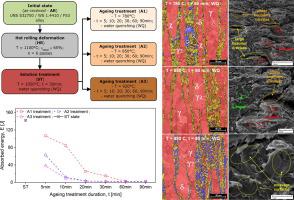Journal of Advanced Research ( IF 11.4 ) Pub Date : 2020-11-14 , DOI: 10.1016/j.jare.2020.11.005 Elisabeta Mirela Cojocaru , Doina Raducanu , Anna Nocivin , Vasile Danut Cojocaru

|
Introduction
Super-Duplex Stainless Steeles (SDSS) proved an excellent potential for its use in many chemical and offshore applications due to their both high mechanical properties and a high corrosion resistance in chloride ion solutions.
Objectives
This study evaluates the influence of ageing treatment temperature and duration on σ-phase precipitation and mechanical properties of UNS S32750 SDSS alloy.
Methods
The influence of ageing treatment on microstructural features was analysed by SEM-EBSD (Scanning Electron Microscopy - Electron Backscatter Diffraction) technique, while on mechanical properties by tensile and impact testing techniques.
Results
The obtained results show that for the short duration ageing treatments the σ-phase nucleates, within the δ-phase matrix, at the δ/γ grains boundary by the δ → σ precipitation, while for long duration ageing treatments the σ-phase nucleates, within the δ-phase matrix, at the δ/δ grains boundary, or in other favourable nucleation sites, due to the eutectoid decomposition δ → σ + γ2. Experimental data showed that at low temperatures, i.e. 780 °C, in order to induce the precipitation of σ-phase, the minimum incubation time is situated close to 20 min, and that increasing treatment temperature decreases the minimum incubation time, with at 850 °C and 920 °C the σ-phase being firstly detected at 5 min. The σ-phase precipitation shows the highest precipitation kinetics at 850 °C, when the maximum weight-fraction is obtained for each treatment duration when compared with ageing treatments performed at 780 °C and 920 °C.
Conclusion
All presented data brings valuable insight into the σ-phase precipitation phenomena and its influence on UNS S32750 SDSS alloy’s exhibited mechanical properties and, also, can provide researchers and industrial steel processors a guide regarding the selection of optimal ageing treatment parameters to avoid/minimise the embrittlement induced by the precipitation of deleterious σ-phase.
中文翻译:

时效温度和时长对UNS S32750 SDSS合金的σ相析出和力学性能的影响
介绍
超级双相不锈钢(SDSS)具有很高的机械性能和在氯离子溶液中的高耐腐蚀性,因此在许多化学和海上应用中具有极好的潜力。
目标
本研究评估了时效处理温度和时长对UNS S32750 SDSS合金的σ相析出和力学性能的影响。
方法
通过SEM-EBSD(扫描电子显微镜-电子背散射衍射)技术分析了时效处理对微观结构特征的影响,同时通过拉伸和冲击测试技术分析了其对机械性能的影响。
结果
所得结果表明,对于短时效时效处理,δ相在δ/γ晶界处由δ→σ析出,在δ相基体内,σ相成核,而对于长时间时效处理,σ相成核, δ相基质中,在δ/δ晶粒边界,或者在其他有利的成核位点,由于共析分解δ→σ+γ 2。实验数据表明,在低温(即780°C)下,为诱导σ相沉淀,最短孵育时间位于20分钟附近,并且随着处理温度的升高,最短孵育时间在850°C时降低。 C和920°C时,在5分钟时首先检测到σ相。当与在780°C和920°C下进行的时效处理相比,在每个处理时间内获得最大重量分数时,σ相沉淀在850°C时显示出最高的沉淀动力学。
结论
所有提供的数据为σ相沉淀现象及其对UNS S32750 SDSS合金表现出的机械性能的影响提供了宝贵的见解,并且还可以为研究人员和工业钢加工商提供有关最佳时效处理参数选择的指南,以避免/最小化合金的时效。有害的σ相的析出引起的脆化。











































 京公网安备 11010802027423号
京公网安备 11010802027423号